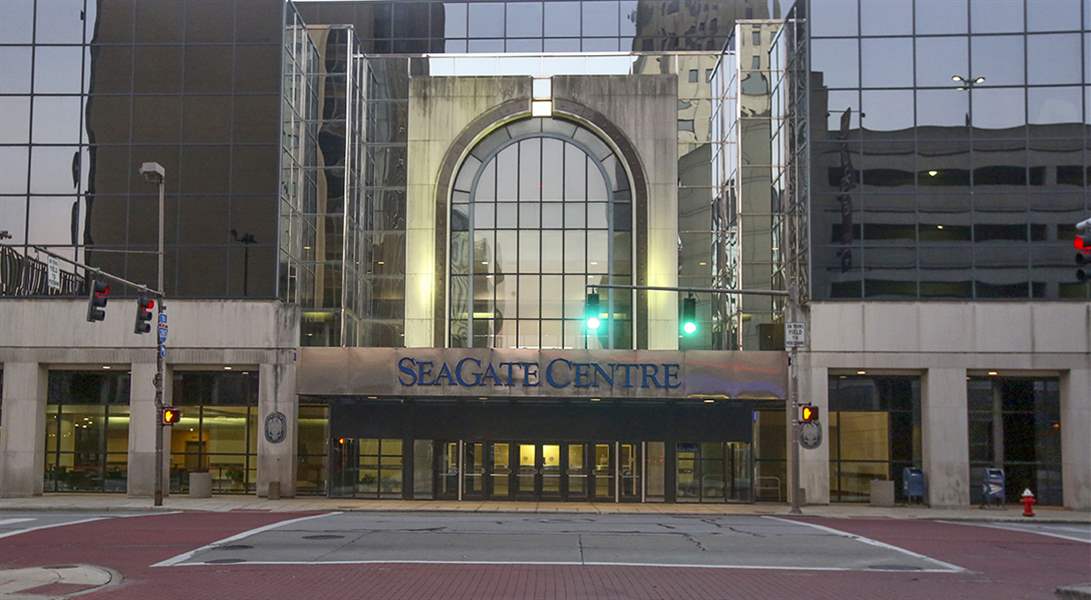
Study calls for downtown area overhaul
Removal of bus loop, renovations part of plans
11/7/2016
The master plan, commissioned by the 22nd Century Committee, suggested that the SeaGate Convention Centre could be moved or renovated and expanded.
THE BLADE/KATIE RAUSCH
Buy This Image
The latest report detailing a 20-year vision for downtown Toledo’s future — commissioned by a now defunct public-private partnership group — outlines what officials believe to be lofty but not insurmountable goals for the central business district that has struggled to re-emerge as a thriving area after decades of decline.
Recommendations for the downtown master plan have been solicited and presented by urban planners and architects during several public meetings since January.
MKSK, a Columbus-based landscape architecture, urban design, and planning firm hired to conduct the study, has repeatedly stressed in the various versions of reports that the Maumee River is underutilized and it is important that people be able to walk the length of the waterway on both sides.
There has been momentum with developments like Fifth Third Field, Huntington Center, Hensville, ProMedica’s new headquarters, and the new Middlegrounds Metropark, the report shows. But it said more work is needed to make the area more pedestrian-friendly, including developing more residential units, renovating the vacant Nasby, Spitzer, and Nicholas buildings at Huron Street and Madison Avenue, and moving the existing bus loop.
“Removal of the dedicated bus loop frees this valuable public real estate for use by other important, contributing elements,” the report said. “The area regained by removal of the bus loop should be used for on-street parking and additional streetscape in many locations.”
Toledo Area Regional Transit Authority’s top official confirmed in August the agency is considering making an offer to buy The Blade building and parking lot to build a new downtown hub to consolidate its bus service in the central business district.
Summit Street also should be targeted for an overhaul, the report said.
“With the planned removal of the bus loop, there is now an opportunity to right-size Summit Street,” it said. “Instead of a six-lane section with sporadic on-street parking, Summit Street could be narrowed to a five-lane section with on-street parking on both sides.”
The report recommended the Downtown Toledo Development Corporation shepherd its goals through, which would include approval from the city of Toledo for things like changing the design of Summit and altering one-way streets into two-way streets.
Randy Oostra, president and chief executive of ProMedica, and Bob LaClair, president and chief executive officer of Fifth Third Bank in Northwest Ohio — who were both involved with the 22nd Century Committee and now lead the development corporation board of directors as chairman and vice chairman, respectively — lauded the plan.
“Look at the Short North in Columbus and places like that — you have a great ability to park, to shop, and so changing some of the street patterns to do that ... we have to work through that process,” Mr. Oostra said.
The master plan study was commissioned by the 22nd Century Committee, which suggested the SeaGate Convention Centre could be moved to another downtown site or renovated and expanded at its existing location. Mr. LaClair said that would be the most difficult goal from the report.
The proposal addresses potential development, a vision plan for the riverfront and downtown, creating a network of parks, improving streets for pedestrian and bicycling use, and developing strategies growth.
The study noted that only 30 acres in the downtown area are dedicated to parks, about 2 percent of the downtown’s 440 acres.
It again said the city could encourage private investment and attract more residents downtown by offering financial incentives such as tax abatement and assisting in historic tax credits and low-interest loans for developing housing to meet what it called the demand of 1,200 to 1,500 more residential units in the area.
It recommends “bringing back the Four Corners,” the intersection where the Nasby, Spitzer, Nicholas, and Huntington buildings stand.
It recommends “residential reuse” for the historic, city-owned Nasby Building.
Mr. Oostra said it would cost $10 million to $20 million to renovate the building.
“It is going to take a collection solution there,” he said of that intersection.
The 11-story Nasby Building, considered Toledo’s first skyscraper, was named for Petroleum V. Nasby, a Civil War-era fictional character created by former Blade editor David Ross Locke. Once known as the Security Building, it was nine full stories, with two partial floors topped by a steeple-like tower.
The city of Toledo acquired the landmark during the Finkbeiner administration through a tax foreclosure in 2000 when its out-of-town owner threatened to tear it down.
At the time, city officials said its cleanup would allow the site near Huntington Center to be redeveloped by potential investors.
Since then, blight has increased at the intersection.
The Nicholas Building across the street at 608 Madison is vacant and the Spitzer Building at 520 Madison was closed Dec. 1, 2013.
Contact Ignazio Messina at: imessina@theblade.com or 419-724-6171 or on Twitter @IgnazioMessina.